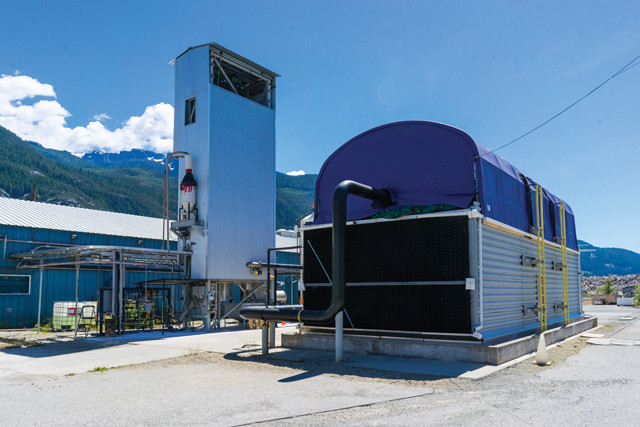
by Mary Caperton Morton Monday, September 10, 2018

Carbon Engineering's proof-of-concept Direct Air Capture (DAC) plant in British Columbia has been harvesting carbon from the air since 2015. Credit: Carbon Engineering.
In the near future, vehicles may be powered by carbon that comes from the sky, rather than out of the ground. Direct Air Capture (DAC) technology pulls carbon dioxide out of the atmosphere and converts the carbon into pellets that can be used to make hydrocarbon fuel that works in traditional engines. A new study details the process, which has been tested over the last three years, and offers some cost-saving solutions that make DAC more economically feasible than ever.
Scrubbing carbon dioxide from air is nothing new; the technology has been around since World War II when the U.S., Japan and other countries figured out how to keep sailors breathing in deepwater submarines by removing exhaled carbon dioxide. But large-scale carbon dioxide harvesting has long been thought to be too pricey: In 2011, a report by the American Physical Society estimated the process would cost between $600 and $1,000 per metric ton of carbon dioxide. But the new endeavor, from a Canadian company called Carbon Engineering, has developed a DAC method that costs as little as $100 per metric ton.
The new study, published in the journal Joule, details the DAC process used by Carbon Engineering at a plant in Squamish, British Columbia, which has been operating since 2015, pulling one ton of carbon dioxide out of the atmosphere per day. “It’s very hard to know how much something will cost to do without actually doing it,” says lead author David Keith, founder of Carbon Engineering and an applied physicist at Harvard University. “Our study is the first to really show the complete end-to-end process with engineering and cost breakdowns.”
The DAC plant in Squamish harvests carbon dioxide from the atmosphere using giant fans to bring the air into contact with a water-based alkali capture solution, which isolates and stores the carbon dioxide in a process that is chemically similar to the pathway that produces pulp and paper from wood, Keith says. “There’s not much carbon dioxide in the air and if you’re going to succeed, the capital costs and operating costs of capturing the carbon dioxide out of the air have to be really cheap.” To bring costs down, the team at Carbon Engineering focused on adapting existing cooling tower technology as the building blocks for the contactors that bring ambient air in contact with the capture solution. “We developed a system that is very similar to the forced cooling towers that are common in the industrial world,” he says, such as in food processing plants to remove heat generated by machinery or in power plants to remove excess heat generated by the production of electricity.
Once the carbon is captured and transformed into carbonate ions, it is stored as stable, transportable calcium carbonate pellets in a process similar to one used by water treatment plants to remove excess ions from wastewater. These pellets can then be stored for carbon sequestration or be turned into a wide variety of hydrocarbon fuels in a high-heat thermo-catalytic pathway known as Air to Fuels technology.

The carbon-neutral fuel produced by Carbon Engineering's DAC plant can be used in traditional engines. Credit: Carbon Engineering.
“The final step synthesizes a drop-in compatible hydrocarbon fuel that is chemically the same as regular hydrocarbons that we use in vehicles,” Keith says. Burning the fuel releases the carbon dioxide that was captured from the air in the first stage of the process. “In this sense, this technology is not a carbon removal application, but a way to repackage the energy into carbon-neutral fuel.”
The new study offers the first detailed look at how a commercial DAC plant can work, says Chris Jones, a chemical engineer at Georgia Tech University who was not involved in the new research. “This paper represents the first comprehensive and detailed peer-reviewed description of the complete DAC technology from start to finish. It represents hundreds of incremental improvements that the Carbon Engineering team made on a basic design that has been around for at least 10 years.”
“There are many different ways to achieve DAC and many variations are still to be explored,” Jones says. Carbon Engineering has picked one out of many possible ways, he says. “It’s possible there’s a better way to do this, but they’re on the right track. It’s a really exciting time for this technology. I really think it’s going to take off.”
The next steps will be to build a bigger commercial plant, Keith says. “We think, without wild extrapolation, that we could build a 2,000-barrel-a-day commercial plant, operational by 2025, that could bring the production process down to about $1 a liter” (about $3.80 a gallon) for carbon-neutral fuel. That’s not much more than petroleum-based fuels, and costs will likely come down as the technology develops, he says.
Ultimately, each DAC facility could be built to capture 1 million tons of carbon dioxide a year, equivalent to the emissions from 250,000 cars. “DAC won’t magically solve our climate problems, but it could be an important tool in managing carbon dioxide emissions,” Keith says. “It’s important to remember that we can’t solve the problem of too much carbon dioxide in the atmosphere just by taking carbon dioxide out of the air. We still need to address the core issue — that we’re still emitting huge amounts of carbon dioxide into the atmosphere.”
© 2008-2021. All rights reserved. Any copying, redistribution or retransmission of any of the contents of this service without the expressed written permission of the American Geosciences Institute is expressly prohibited. Click here for all copyright requests.